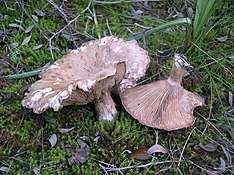Clitocybe alexandri
Clitopaxillus alexandri is a species of edible mushroom classified under the genus Clitocybe in the family Tricholomataceae. Although it is edible and the flavor is good, it is rarely collected for consumption, for it is lesser known. It can be confused with 'Lepista rickenii, another edible species.[1]
| Clitocybe alexandri | |
|---|---|
 | |
| Clitopaxillus alexandri | |
| Scientific classification | |
| Kingdom: | |
| Division: | |
| Class: | |
| Order: | |
| Family: | |
| Genus: | Clitopaxillus |
| Species: | C. alexandri |
| Binomial name | |
| Clitopaxillus alexandri | |
Description
The cap is grayish brown, 5–10 cm and darkens with age. It is often scarred and discolored. In its early stages, the pileus (cap) is convex, and flattens through development, eventually creating a dish shape and becoming concave. The edge of the cap is also very fragile and rolled, which causes it to break often throughout the development of the fruit body.[2] The lamellas are a lighter color and darken with age, turning ocher then a brown. The flesh smells of grass and is an ocher color. It is very spongy and easily cut.[1] Spore print is white and made up of smooth, ellipsoidal spores measuring 5-7 x 3.5-4 μm.[2]
Usually found in coniferous forests after rain storms. It also can be found in meadows.
Edibility
It can be used in culinary activities, and has an agreeable flavor, although it is seldom collected.[2]
References
- Pérez, Javi Calvo. "Clitocybe alexandri". Fungipedia (in Spanish). Retrieved 2019-05-15.
- "Clitocybe alexandri". www.amanitacesarea.com. Retrieved 2019-05-15.